JAPANESE KITCHEN KNIVES
Reviews of The Best Japanese Kitchen Knives 2022
16.02.2020
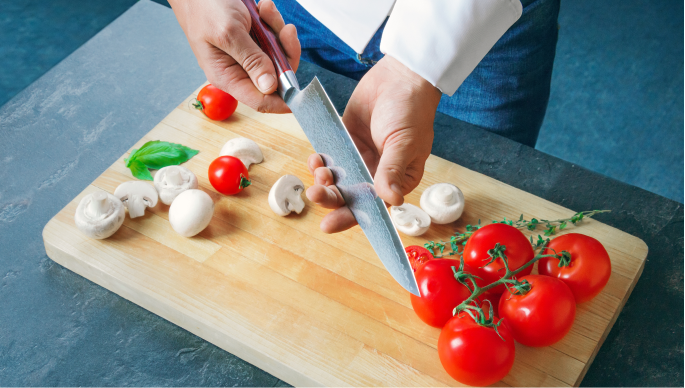
Japanese kitchen knives, also known as bōchō/hōchō, feature the most exquisite craftsmanship on the market. These knives allow for more precise and cleaner cuts compared to their European counterparts.
As such, most chefs in the high-end restaurants use them, and considering how fun cooking can be with these classy and quality knives, why shouldn’t you have one in your kitchen?
To help you land the best Japanese kitchen knife for your cooking, our experts came up with the information you need up yout sleeve before you go shopping. Read on.
What Sets Japanese Knives Apart?
A few features of the Japanese knives set them apart from the rest. You can think of these qualities are their identifiers when you go shopping for a knife. They are:
Beautiful Design
When it comes to design, the Japanese knives boast of lightweight and ergonomics compared to their European counterparts. If you are looking to complement your kitchen’s interior décor with cutlery, then buying a Japanese kitchen knife set might be the secret.
Retained Sharpness
The history of Japanese knives dates to the ancient times of sword making. Thanks to the years of evolution, these knives are made to maintain their sharp edges for a long while. For this reason, Japanese knives can give you the perfect slices with the utmost precision. These are the chops and cuts you get in most Japanese cuisine.
Quality Craftsmanship
With the many years of making knives, you get improvements in craftsmanship. This tradition has been passed down from one generation to the next, and the result is quality. If you land an excellent Japanese knife and give it the care it deserves, you will have it for a decade, probably more.
Awesome Handles
You probably have experience with or heard about the big handles of many European knives. The Japanese manufacturers focus on making comfortable handles on their knives and being able to use one for a long time. For this reason, their handles are small and easy to get a firm grip. This and the fact that they are mostly lightweight, you can use your knife for hours on end! Really.
Main Types of Japanese Knives
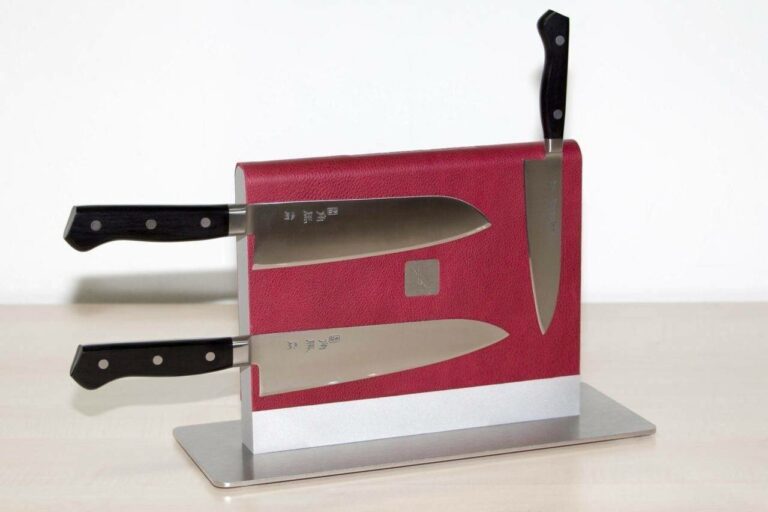
Santoku
This is one of the most common types of Japanese knives. It is an all-purpose knife used for fish, meat, and vegetables. The anatomy of this knife involves wide blades reaching lengths of about 8 inches with more rounded tips compared to the others.
Gyuto
Gyuto in Japanese means beef sword, implying that it was designed to be used to cut meat. However, its ability to handle several other tasks with impressive precision made it be used for more. The Gyuto knife usually measures about 8 to 12 inches. It is lightweight with a slightly curved belly. This is the chef’s knife.
Usuba
The Usuba knife looks like the big meat cleaver you might have seen before, but it is used for the preparation of vegetables. The thin blades and sharp edges make them ideal for thin and perfect slices of the ingredients. This is especially important for preparing Japanese cuisine.
Sashimi
Sashimi is a type of fish from where the knife got its name. This tells you the primary purpose of the knife — filleting, slicing, and portioning. The main feature of this knife is the single-side bevel. The other flat side of the blade ensures smooth and precise slices.
Deba
Like the Sashimi, the Deba Japanese kitchen knives have single bevels. They are explicitly used for filleting and come with curved spines and tips. The thick blades on the Deba knives make them perfect for cutting through large fish bones.
Keeping Your Japanese Kitchen Knife Sharp
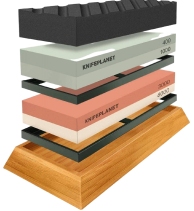 Regular use of your Japanese knife will likely blunt the edge and reduce its sharpness. The good thing is the ease with which the blades can be sharpened, and with the KnifePlanet’s Knife Sharpening Stone, you can be sure to restore the knife’s razor-sharpness.
Regular use of your Japanese knife will likely blunt the edge and reduce its sharpness. The good thing is the ease with which the blades can be sharpened, and with the KnifePlanet’s Knife Sharpening Stone, you can be sure to restore the knife’s razor-sharpness.
The sharpening stone is made to eliminate the chances of slips and accidents. To make things better for you, a purchase of this sharpening stone will get you a sharpening guide from our experts to make you one.
Best Japanese Kitchen Knives Reviews 2020
Shun Classic 8-inch Chef’s Knife
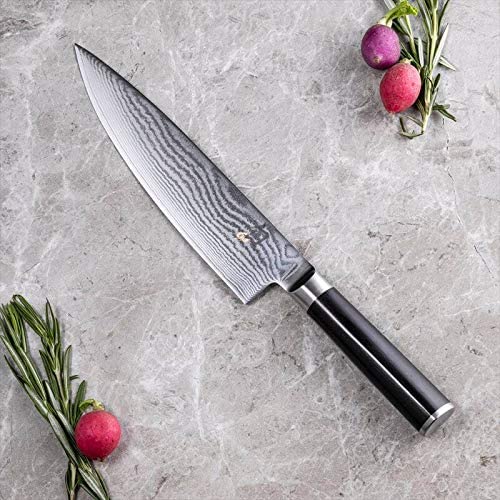
With a look of a crossbreed between a German knife and a Japanese one, the Shun Classic knife is among the renowned Japanese knives. The handle is made from PakkaWood, a hardwood to ensure the durability of the handle and grip.
The blade of the Classic knife is made using the VG-MAX steel formula composed of carbon and cobalt for durability and strength, chromium to resist corrosion, and tungsten for a sharp edge. The blade is slightly curved at the belly to allow for easy chopping and slicing with rocking motions.
Tojiro DP Gyuto

The Tojiro DP Gyuto knife is considerably cheaper than most knives in its category. The best part is that the manufacturer didn’t sacrifice any of the knife’s impressive features. This price tag makes it possible for novices and low spenders to experience the Japanese kitchen knives with quality and functional knife.
The handle of this gyuto is the same as what you will get in most European knives. It has three rivets and a beautiful finish. The blade is made from VG-10 steel that will resist corrosion and retain its sharpness for quite a long time. Should you need to sharpen the knife, its softer outer coat of steel on the blade makes it easy. Overall, this is the best pick if you are on a budget but looking for quality.
Yoshihiro VG10 Japanese 8.25” Knife
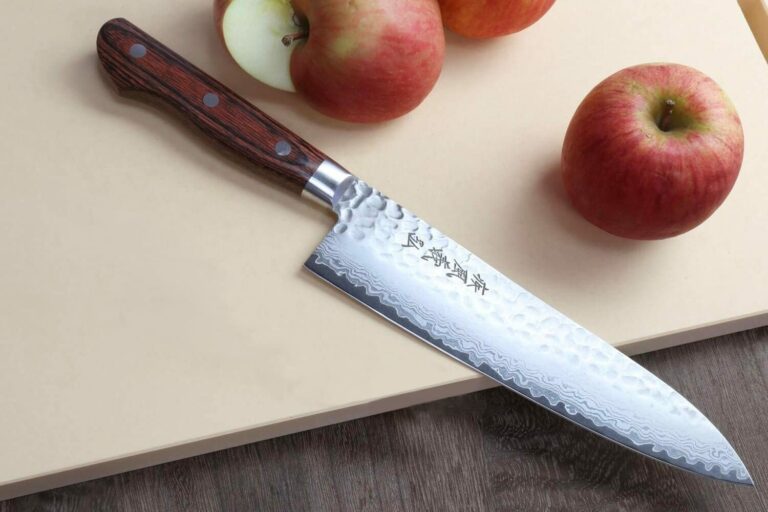
Another excellent pick for entry-level cooks looking to explore Japanese craftsmanship is the Yoshihiro gyuto knife. The knife comes with three layers of VG-10 stainless steel core to not only ensure its strength but durability as well. It is a versatile piece of cutlery that you should have in your kitchen with the ability to handle all cutting tasks such as slicing, dicing, chopping, and carving.
The stylish outer layer of the blade is made from Damascus steel to withstand corrosion the entire time you will use it. To enhance its functionality, the blade is designed to prevent food from sticking to it and reduce friction. The handle is made from Mahogany, and its full tang construction gives you a balanced weight for efficient use.
Zelite Infinity 7-inch Santoku Knife
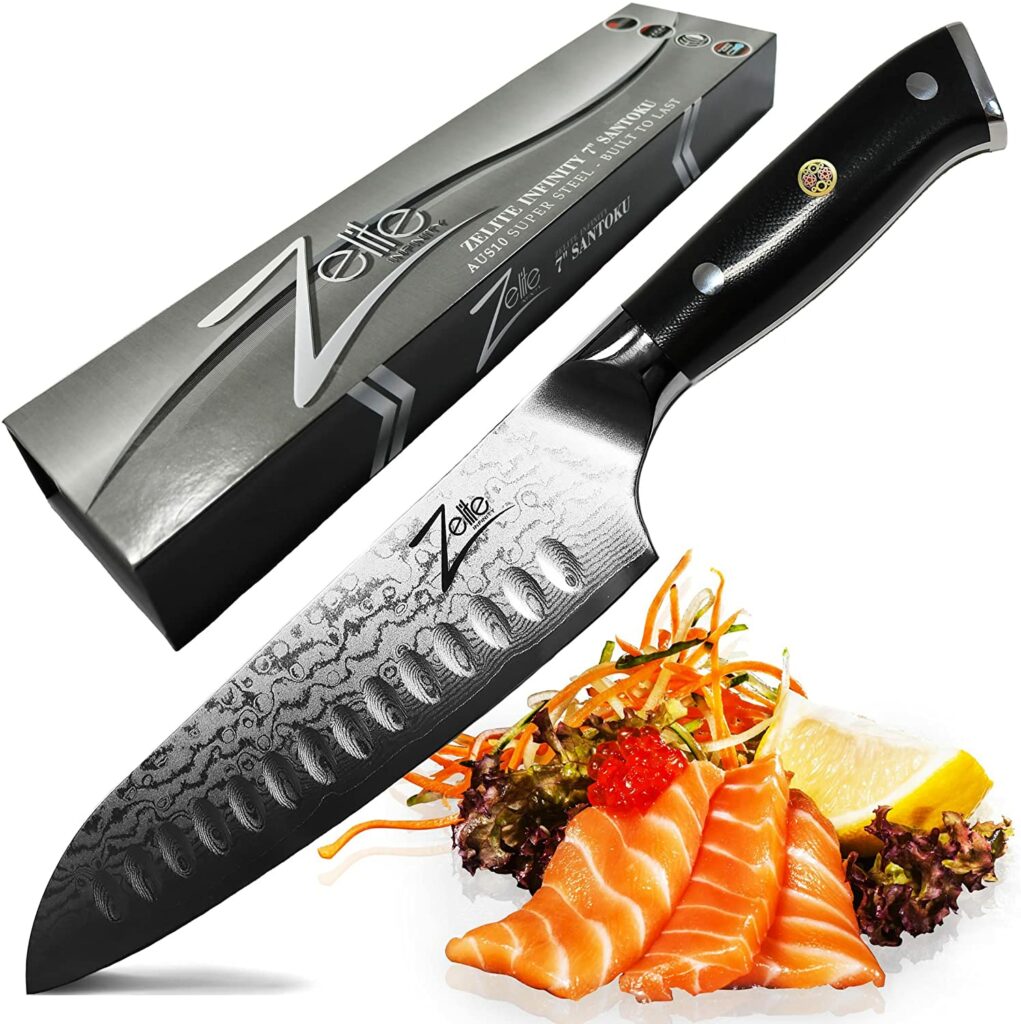
Besides its ability to handle several cutting tasks in the kitchen, the Zelite Infinity knife has an elegant finish to complement your kitchen interior. The 7-inch blade gives you control over the motions of the knife with more maneuverability compared to the long blades. Another impressive thing about the knife’s design is the full tang that balances off its weight between the blade and the ergonomic handle.
The blade is made from high-quality high-carbon steel to resist corrosion and discoloration. Dimples on the blade also ensured seamless slicing and chopping by preventing food from sticking to it. Your Zelite Infinity knife will be razor-sharp right from the box, and you can be sure that it will maintain its edge. Unlike most Japanese knives, this one is a little heavier.
DALSTRONG Shogun Series 8-inch Japanese Knife
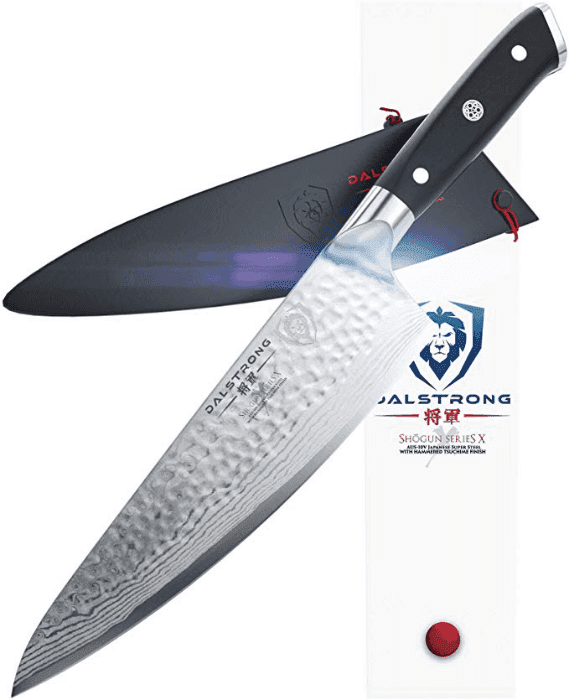
Dalstrong is known to produce quality craftsmanship and utility, and the Shogun Series of their knives are no different. The premium high-carbon stainless steel used to make the blade of this knife is a guarantee enough that the blade is not only strong but also resistant to corrosion and rust. The blade comes with a sharp edge, which you will likely not need to sharpen, at least not any time soon after purchase.
The blade is firmly riveted on the handle with the full tang design. What this gives you is the robustness of the knife, balanced weight, and durability. The handles are slightly contoured to fit in hand and enhance a firm grip. In addition to looking good in your kitchen, this Dalstrong beauty will also make your cooking more enjoyable and efficient.
Tips for Caring for Your Japanese Kitchen Knives
Japanese knives, unlike most German knives, require a rather strict maintenance regimen for durability. The blades are usually thinner and can easily chip if not cared for. The following are some tips to keep your knife serving you for a long time:
Cutting Surface
If you are looking to maintain the edge of your Japanese blade, avoid glass chopping boards and use wood boards instead. Poly and bamboo boards have also been found to damage the edge of the knives.
Washing
Handwashing is recommended for most Japanese knives, and the one you will buy will most likely not be different. Do not put your knife in the dishwasher since the hot water and chemicals and random movements might end up damaging the handle and the blade.
Sharpening
It is good to maintain a sharp edge on your blade, but if not done professionally, you might destroy the edge altogether. The KnifePlanet’s premium whetstone comes with a professional guide on how to use, which should be everything you need to maintain your Japanese kitchen knife.
Conclusion
With this information, you are ready to not only acquire the best Japanese kitchen knife but also care for it. Our list of reviewed knives gives you the best starting point for your search.









